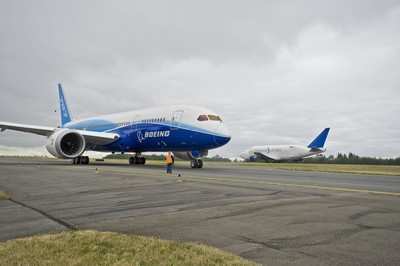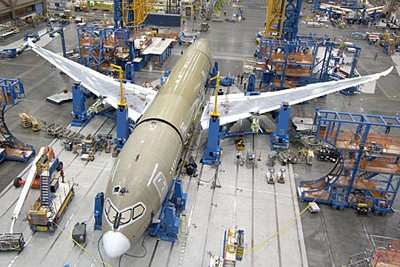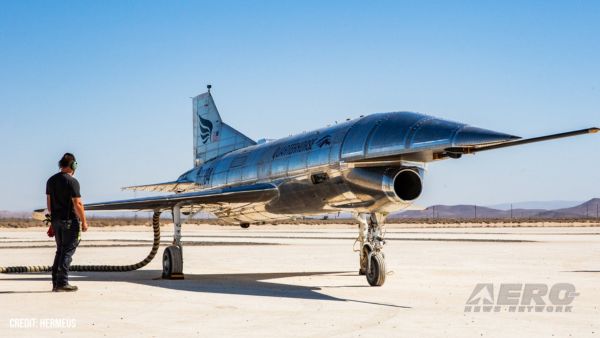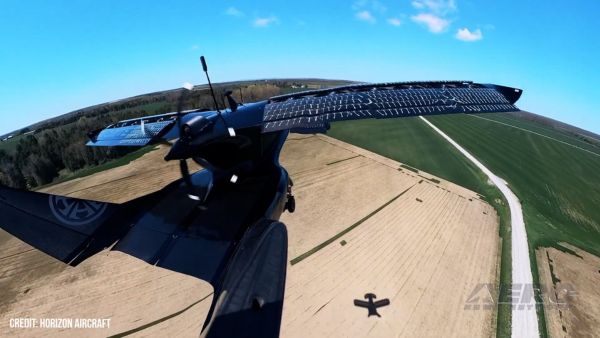Fri, Aug 28, 2009
Test Airplane And Static Test Units Are Prepped For Wing And
Fuselage Modifications
We've been hearing this for a week or so, but Boeing has finally
made it official. The company announced late Thursday that the
first flight of the 787 Dreamliner is expected by the end of 2009
and first delivery is expected to occur in the fourth quarter of
2010.

The new schedule reflects the previously announced need to
reinforce an area within the side-of-body section of the aircraft,
along with the addition of several weeks of schedule margin to
reduce flight test and certification risk. The company projects
achieving a production rate of 10 airplanes per month in late
2013.
"This new schedule provides us the time needed to complete the
remaining work necessary to put the 787's game-changing capability
in the hands of our customers," said Boeing Chairman, President and
Chief Executive Officer Jim McNerney. "The design details and
implementation plan are nearly complete, and the team is preparing
airplanes for modification and testing."

Based on the revised schedule and other assumption updates, the
company has determined that the 787 program is not in a
forward-loss position.
However, separate from the updated program profitability
assessment, the company has concluded that the initial flight-test
airplanes have no commercial market value beyond the development
effort due to the inordinate amount of rework and unique and
extensive modifications made to those aircraft. Therefore, costs
previously recorded for the first three flight-test airplanes will
be reclassified from program inventory to research and development
expense, resulting in an estimated non-cash charge of $2.5 billion
pre-tax, or $2.21 per share, against third-quarter results. This
charge will have no impact on the company's cash outlook going
forward.
The 787 team working the side-of-body reinforcement has
completed initial testing and is finalizing design details of new
fittings that are expected to ensure full structural integrity of
the joint. The static test procedure that uncovered the issue will
be repeated and the results fully analyzed before first flight is
conducted. Fatigue testing also will be performed on stringer
components to validate the long-term durability of the
modification.

The first 787 test airplane and static test unit have been
prepared for the new fittings. Installation is expected to begin
within the next few weeks.
More News
From 2021: The Inside Skinny On What Being An ANN Oshkosh Stringer Is All About By ANN Senior Stringer Extraordinare, Gene Yarbrough The annual gathering at Oshkosh is a right of p>[...]
Pilot Asked The Mechanic To Go For A Test Flight Around The Airport Traffic Pattern With Him For A Touch-And-Go Landing, And Then A Full-Stop Landing On May 7, 2025, about 1600 eas>[...]
From 2010 (YouTube Edition): Skiles Reflects On His Ring-Side Seat To An Historic Event Jeff Skiles, First Officer of US Airways Flight 1549, "The Miracle on the Hudson," was the g>[...]
“The FAA conducted a comprehensive safety review of the SpaceX Starship Flight 8 mishap and determined that the company has satisfactorily addressed the causes of the mishap,>[...]
Fuel Remaining A phrase used by either pilots or controllers when relating to the fuel remaining on board until actual fuel exhaustion. When transmitting such information in respon>[...]
 Oshkosh Memories: An Aero-News Stringer Perspective
Oshkosh Memories: An Aero-News Stringer Perspective NTSB Prelim: Diamond Aircraft Ind Inc DA 40 NG
NTSB Prelim: Diamond Aircraft Ind Inc DA 40 NG Classic Aero-TV: US Airways Jeff Skiles-Making History and Looking To The Future
Classic Aero-TV: US Airways Jeff Skiles-Making History and Looking To The Future Aero-News: Quote of the Day (05.26.25)
Aero-News: Quote of the Day (05.26.25) ANN's Daily Aero-Term (05.26.25): Fuel Remaining
ANN's Daily Aero-Term (05.26.25): Fuel Remaining





